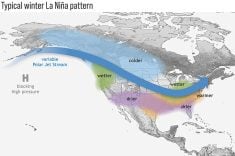Manitoba farmers trying to get re-oriented after the loss of the Crow should think about Chinese vegetables.
Les Allen, a horticulturist with Manitoba Agriculture, said there is a growing market in Canada for Chinese vegetables and large grocery chains are keen on securing local supply.
The demand is part of a North American trend toward eating healthier, but is also due to growing ethnic populations in some of Canada’s larger cities, Allen said during a seminar at the Manitoba Horticulture Conference in Brandon Feb. 5.
He said British Columbia and Ontario don’t grow enough to supply the demand in larger cities.
Read Also

Canadian Food Inspection Agency extends chronic wasting disease control program consultation deadline
Date extended for consultation period of changes to CWD program
“Now supply is low, but if we can be competitive with good quality product, we’ll see buyers give a fair shake to Manitoba producers,” Allen said.
Last year was the first for a research project funded by the Vegetable Growers Association of Manitoba who wanted to know if oriental vegetables are a viable crop for the province.
Large grocery chains such as Superstore and Safeway raised the idea when they approached the association. They’d like to buy locally grown oriental vegetables instead of taking them from California.
Supermarket study
Oriental vegetables are rare in fields across the Prairies, but that could soon change. A market analysis conducted by Manitoba Agriculture in conjunction with Superstore and Safeway showed it could pay off.
Over 50 crops and varieties were tested during the first year of trials, all on irrigated sites.
The main production problems with growing oriental vegetables are bolting and flea beetles, Allen told the conference.
“When the plant bolts and once the flower emerges, the part of the plant you want to harvest has gone to seed,” he said.
And producers are on their own dealing with pests. There are no registered products for oriental vegetables, he said.
While interest in the new crops is growing, Allen warned it would only take two or three farmers growing a few acres to flood the Manitoba market.
That’s why he suggested interested growers contact the vegetable association to find out where the gaps exist.
“This is a guess but I would guess that in any one commodity if we start pushing in a handful of acres, more than two or three acres, we could probably be running into oversupply,” Allen said.
Here is a list of some of the vegetables the study looked at:
- Bok choy – identified by Superstore as having strong market demand. With the short season, it is possible to do three plantings a season. Yield potential is up to 40,000 pounds per acre at about 25 cents a pound. Problems: Bok choy has a tendency to bolt and flea beetles are a problem.
- Yu choy – several potential markets in Winnipeg. Yu choy has excellent yield potential and could fetch slightly over $1 per lb. Flea beetles are also a problem for this crop.
- Watercress – good market potential and direct sales prices can reach up to $3 per lb.
- Gai lan – also called Chinese broccoli. This vegetable also has a tendency to bolt and can be infected by cabbage worm.
- Suy choy – also called Chinese cabbage. Yields can be very high, up to 50,000 lb. per acre, and can fetch up to 60 cents a lb.
- Hot peppers – lots of demand for Jalapeno, Serrano and Anaheim varieties. Yields up to 12,000 lb. per acre at about 80 cents a lb.














